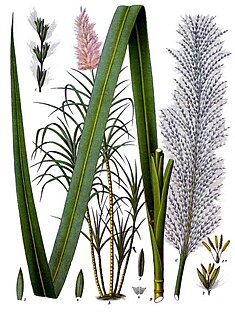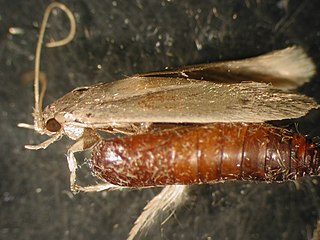
Eriophyidae is a family of more than 200 genera of mites, which live as plant parasites, commonly causing galls or other damage to the plant tissues and hence known as gall mites. About 3,600 species have been described, but this is probably less than 10% of the actual number existing in this poorly researched family. They are microscopic mites and are yellow to pinkish white to purplish in color. The mites are worm like, and have only two pairs of legs. Their primary method of population spread is by wind. They affect a wide range of plants, and several are major pest species causing substantial economic damage to crops. Some species, however, are used as biological agents to control weeds and invasive plant species.
Paraburkholderia sacchari is a species of bacteria in the phylum Proteobacteria. It was isolated in the 1990's from sugarcane crop soil, and later identified as a new bacterial species, originally named as Burkholderia sacchari. Paraburkholderia sacchari was found to be capable of creating and accumulating polyhydroxyalkanoates (PHA) by incorporating different monomers. This strain was subject of a number of genetic and bioproccess engineering studies conducted worldwide aiming to establish PHA production from different substrates, especially using agro-industrial byproducts.
Bipolaris sacchari is a fungal plant pathogen in the family Pleosporaceae.
Dimeriella sacchari is a species of fungus in the family Parodiopsidaceae. It is a plant pathogen that causes red leaf spot on sugarcane.
Stagonospora sacchari is a fungal plant pathogen infecting sugarcane.

Abacarus sacchari, the sugarcane rust mite, is an agricultural pest mite mostly on sugar cane plantations in Africa, Brazil, India, Guatemala, Costa Rica and Venezuela.
Heterodera sacchari, the sugarcane cyst nematode, mitotic parthenogenic sedentary endoparasitic nematode. This plant-parasitic nematode infects the roots of sugarcane, and the female nematode eventually becomes a thick-walled cyst filled with eggs. Aboveground symptoms are species specific and are similar to those caused by other Heterodera species. Symptoms include: stunted and chlorotic plants, and reduced root growth. Seedlings may be killed in heavily infested soils.

Sugarcane or sugar cane is a species of tall, perennial grass that is used for sugar production. The plants are 2–6 m (6–20 ft) tall with stout, jointed, fibrous stalks that are rich in sucrose, which accumulates in the stalk internodes. Sugarcanes belong to the grass family, Poaceae, an economically important flowering plant family that includes maize, wheat, rice, and sorghum, and many forage crops. It is native to the warm, temperate tropical regions of India, Southeast Asia, and New Guinea. The plant is also grown for biofuel production, especially in Brazil, as the canes can be used directly to produce ethyl alcohol (ethanol).

Sugarcane grassy shoot disease (SCGS), caused by ‘Candidatus Phytoplasma sacchari’ which are small, pleomorphic, pathogenic bacteria that contributes to yield losses from 5% up to 20% in sugarcane. These losses are higher in the ratoon crop. A higher incidence of SCGS has been recorded in some parts of Southeast Asia and India, resulting in 100% loss in cane yield and sugar production.

Opogona sacchari, the banana moth, is a moth of the family Tineidae. The species was first described by Wenceslas Bojer in 1856. It is native to the humid tropical and subtropical regions of sub-Saharan Africa, where it is also found in Madagascar, Mauritius, Réunion, Rodrigues Island, the Seychelles and St. Helena. It was first reported from the Canary Islands in the 1920s. In the 1970s, it was introduced into Brazil and Central America, and also appeared in Europe. It has been reported from Florida since 1986.
Oligonychus sacchari, the sugarcane mite, yellow mite or sugarcane yellow mite, is a species of mite.
Duganella radicis is a bacterium from the genus Duganella in the Oxalobacteraceae family which was isolated with Duganella sacchari from the rhizosphere of field-grown sugarcane.
Duganella sacchari is a bacterium of the genus Duganella in the Oxalobacteraceae family which was isolated with Duganella radicis from the rhizosphere of field-grown sugarcane.
Commonly known as Philippine downy mildew, this disease is caused by the species Peronosclerospora philippinensis of the fungal-like protist class Oomycetes, which also has members such as water molds and Phytophthora infestans, which caused the potato blight that led to the Great Irish famine.
Gluconacetobacter sacchari is a species of acetic acid bacteria first isolated from the leaf sheath of sugar cane and from the pink sugar-cane mealy bug on sugar cane growing in Queensland and northern New South Wales. The type strain of this species is strain SRI 1794T. It is notable for its production of bacterial cellulose and for being an endophyte in sugar cane.

Oligonychus is a genus of mites in the family Tetranychidae, the spider mites. Many members of this genus are familiar pests of plants. There are about 200 described species.
The sugarcane aphid,, is an aphid in the superfamily Aphidoidea in the order Hemiptera. It is a true bug and sucks sap from plants. It is mostly found in Saccharum and Sorghum species.
Sufetula sacchari is a moth in the family Crambidae. It was described by Francisco Seín Jr. in 1930. It is found in Puerto Rico.
Novius amabilis is a species of lady beetle native to India and Sri Lanka.





